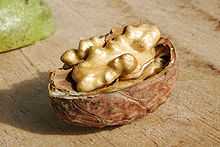Juglandaceae
| Juglandaceae | |
|---|---|
 | |
| Juglans regia | |
| Scientific classification | |
| Kingdom: | Plantae |
| Clade: | Angiosperms |
| Clade: | Eudicots |
| Clade: | Rosids |
| Order: | Fagales |
| Family: | Juglandaceae DC. ex Perleb[1] |
| Subfamilies | |
|
See text | |
| Synonyms | |
|
Platycaryaceae Nakai ex Doweld Pterocaryaceae Nakai, nom. inval. Rhoipteleaceae Hand.-Mazz., nom. cons.[2] | |
Juglandaceae, also known as the walnut family, is a family of trees, or sometimes shrubs, in the order Fagales. Various members of this family are native to the Americas, Eurasia, and Southeast Asia. Members of the walnut family have large, aromatic leaves that are usually alternate, but opposite in Alfaroa and Oreomunnia. The leaves are pinnately compound, or ternate, and usually 20–100 cm long.
The trees are wind-pollinated, and the flowers are usually arranged in catkins.
The eight genera in the family include the commercially important nut-producing trees walnut (Juglans), pecan (Carya illinoinensis), and hickory (Carya). The Persian walnut, Juglans regia, is one of the major nut crops of the world. Walnut, hickory, and gaulin are also valuable timber trees.
Systematics
The known living genera are grouped into subfamilies, tribes, and subtribes as follows:[3]
Subfamily Engelhardioideae
- Alfaroa Standl. – gaulin
- Engelhardia Lesch. ex Blume – cheo
- Oreomunnea Oerst.
Subfamily Juglandoideae
Tribe Platycaryeae
- Platycarya Siebold & Zucc.
Tribe Juglandeae
Subtribe Caryinae
- Carya Nutt. – hickory and pecan
- Annamocarya A.Chev.
Subtribe Juglandinae
- Cyclocarya Iljinsk – wheel wingnut
- Juglans L. – walnut
- Pterocarya Kunth – wingnut
Incertae sedis
- Rhoiptelea Diels & Hand.-Mazz.[4]


The only member of the genus Alfaropsis I.A.Iljinsk., Alfaropsis roxburghiana (Wall.) I.A.Iljinsk. is a synonym for Engelhardia roxburghiana Wall. (or perhaps vice-versa).
The only member of the genus Annamocarya A.Chev., Annamocarya sinensis (Dode) J.-F.Leroy, may actually be a member of Carya.
Fruits
Some fruits are borderline and difficult to categorize. Hickory nuts (Carya) and walnuts (Juglans) grow within an outer husk; these fruits are sometimes considered to be drupes or drupaceous nuts, rather than true botanical nuts. "Tryma" is a specialized term for such nut-like drupes.[5][6]
The fruits of the Juglandaceae are often confused with drupes but are actually accessory fruit because the outer covering of the fruit is technically an involucre and thus not morphologically part of the carpel; this means it can not be a drupe but is instead a drupe-like nut. These odd nuts fall into two different types: in the walnut genus (Juglans), it is a pseudodrupe and in the hickory genus (Carya), it is a tryma.[7]
References
- ↑ Angiosperm Phylogeny Group (2009). "An update of the Angiosperm Phylogeny Group classification for the orders and families of flowering plants: APG III" (PDF). Botanical Journal of the Linnean Society 161 (2): 105–121. doi:10.1111/j.1095-8339.2009.00996.x. Retrieved 2013-07-06.
- ↑ "Family: Juglandaceae DC. ex Perleb, nom. cons.". Germplasm Resources Information Network. United States Department of Agriculture. 2003-01-17. Retrieved 2011-11-17.
- ↑ Manos, P. S.; D. E. Stone (2001). "Evolution, phylogeny and systematics of the Juglandaceae". Annals of the Missouri Botanical Garden 88: 231–269.
- ↑ "GRIN Genera of Juglandaceae". Germplasm Resources Information Network. United States Department of Agriculture. Retrieved 2011-11-17.
- ↑ Armstrong, W.P. "Identification Of Major Fruit Types". Wayne's World. Retrieved 2011-11-17.
- ↑ Armstrong, W.P. (2009-03-15). "Fruits Called Nuts". Wayne's World. Retrieved 2011-11-17.
- ↑ John Derek Bewley, Michael Black, Peter Halmer (2006) The Encyclopedia of Seeds: Science, Technology And Uses
| Wikimedia Commons has media related to Juglandaceae. |
| Wikispecies has information related to: Juglandaceae |
| Wikisource has the text of the 1920 Encyclopedia Americana article Juglandacæ. |